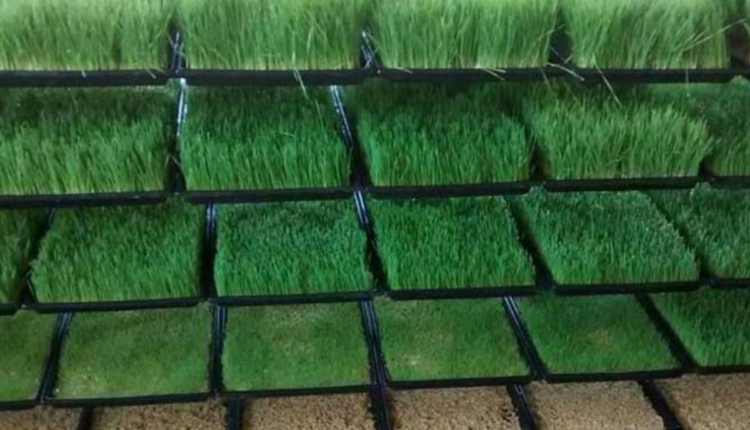Greenhouse farming is becoming very famous in today’s time. Greenhouse farming is being done on a large scale in countries around the world. It is like a boon for farmers to save their crops from the vagaries of weather. Greenhouse farming protects crops from hailstorms, storms, sunlight. Along with this, with its help, farmers can also cultivate those crops which are not grown in the rest of the months. In Greenhouse Cultivation, farmers can enjoy the taste of those fruits and vegetables which are not available in that season. Let us know what greenhouse farming is and how it is done, as well as how farmers can get more benefits from greenhouse farming.
What is a greenhouse?
You can divide greenhouses into glass greenhouses and plastic greenhouses, but the most popular technology is the greenhouse made of plastic mesh. It is like a circle-shaped frame. Mostly pointed roofs are prepared in greenhouses. On top of which glass or polycarbonate panels are installed. For cultivation in greenhouses, those crops are selected which require less light. Also, such crops are selected which do not require high temperature. In greenhouse farming, farmers can produce crops throughout the year or in some months of the year as per their requirement. In greenhouse farming, farmers can easily grow those crops which are related to off-season production. Hydroponics method is also used in greenhouses.
Shade Net House designed for Greenhouse Farming
Shade houses are such designs which are covered with woven or any prepared material, so that sunlight, moisture and air ventilation can be done properly and shade houses are mostly used for hydroponic systems, where the weather is hot. Covering materials are used to provide a specific environmental modification, such as protection from low light or severe weather conditions. Shade houses vary in height depending on the crop being grown, and can reach up to 8 meters high.
Multi-Span Shape
Multi-span greenhouses have a smaller area than many single span greenhouses of the same production capacity. This reduces heat loss, and saves energy. Using multi-span designs offers the advantage of greater scale and production capacity. The most important feature of multi-spans is that their designs are more robust, which reduces damage during storms and hurricane winds.
Screen Houses
Screen houses are greenhouses designed to be covered with insect screening material instead of plastic or glass. They provide protection from environmental modifications and severe weather conditions as well as preventing pests from entering. They are mostly used in warm climate locations.
Classification of Greenhouse
Greenhouses are classified on the basis of demand and cost. This helps a lot to those farmers who want to grow crops through greenhouse.
Low Cost Greenhouse
Low cost greenhouses have structures made with bamboo and wood. The cladding material is made of ultraviolet (UV) film. There is no special management of environmental conditions inside this type of greenhouse, but light is reduced with the help of shading material.
Medium cost and technology greenhouse
Technology is used in this type of greenhouse. In this, the environmental conditions are controlled. Medium size greenhouses are mostly more than 2 meters high but less than 4 meters. Its total height is usually below 5.5 meters. It has ventilation with the help of roof or wall. Medium level greenhouses are covered with single or double skin plastic film or glass. Medium-cost and high-tech greenhouses increase water efficiency in hydroponic systems.
High-tech greenhouses
High-tech greenhouses have walls that are at least 4 meters thick and are raised to a height of about 8 meters above the ground. This design is both environmentally friendly and yields better yields. There is good ventilation on the roof and side wall vents. These are made of polycarbonate sheeting or glass. High-tech structures usually provide impressive views and require more capital, but the profits are manifold.
Benefits of farming in a greenhouse
The amount of carbon dioxide in a greenhouse is much higher than in the open environment, which increases the process of photosynthesis in plants. This leads to faster crop yield. Apart from this, soil sterilization is done in a good amount in the greenhouse, which reduces the incidence of soil-borne fungi and other diseases.
Minimizing production risks
Being in a closed space can protect crops from damage caused by extreme climatic events such as sudden increase or decrease in temperature. It can also keep crops away from birds and other animals that can harm the crops.
Increase in production
Greenhouse farming increases crop production. In this, crops are grown in a controlled environment. Where the best climatic conditions can be created for the growth of plants.
Accelerating the process of photosynthesis in plants
Greenhouse farming has a high amount of carbon dioxide, which increases the process of photosynthesis in plants and they become ready to produce quickly. Soil sterilization is also good, due to which the attack of soil-borne diseases such as fungus is reduced.
Year-round cultivation of crops growing in a particular season
Greenhouse farming yields 10-12 times more yield than outdoor farms. These are ideal for vegetables and fruit crops, which grow only in a particular season. Farmers can also grow flowers throughout the year thanks to greenhouses. Crops do not require a lot of water.
Reducing production risks
Being in a controlled environment prevents the damage caused to crops in outdoor farming. Crops can be saved from weather related incidents like sudden rise or fall in temperature, or damage caused by storm, rain, hail, frost. Crops are also protected from wild animals and birds.
Profit from greenhouse farming
The yield of crops can be increased by using advanced techniques like hydroponics in greenhouse farming. Farmers can earn two to three times profit from greenhouse farming.
How to start farming in greenhouse?
For farming in greenhouse, you need some initial things, such as related equipment to prepare the structure, labor, good amount of money is needed for raw material. Along with this, knowledge of technology, training and marketing is also very important for farmers. With all this, you can start your greenhouse farming.
Crops grown in greenhouse
In greenhouse farming, crops like gerbera, capsicum, Dutt Rose, cucumber, tomato, lily, strawberry, orchid, gypsophila, limonium, leafy vegetables can be grown. Greenhouse farming also depends on the availability of market, labor and raw materials.
Greenhouse Farming in India
In Karnataka, all types of vegetables and fruits are grown in greenhouses under greenhouse farming. Along with this, in other states of India like Uttar Pradesh, Tamil Nadu, Gujarat, Andhra Pradesh, Odisha, Maharashtra (Greenhouse Farming In India), most greenhouse farming is done in the state of Karnataka. Greenhouse farming is also being done by farmers in Maharashtra, Rajasthan, Bihar, Kerala and Haryana.
Subsidy on construction of greenhouse
The cost of preparation in greenhouse farming is high, for which subsidy is also given by the government. Many state governments in India provide subsidy up to 50 percent to the farmers of their state to help them build greenhouses. In India, the National Horticulture Board provides a maximum subsidy of 50 percent up to Rs 12 lakh. The National Horticulture Mission is providing 50 percent subsidy up to Rs 50 lakh.
Loan for construction of greenhouse
If you are interested in greenhouse farming, then you can take a loan from the bank for this. You have to prepare a project report of your greenhouse farming and show it to the bank. Only after this, the bank provides you a loan, as well as helps in getting subsidy. The bank gives you a loan at 12 percent to 14 percent interest for 5 to 7 years.
How to apply for greenhouse subsidy?
You can get subsidy on greenhouse farming through the horticulture department of your state. The government gives 50 to 60 percent subsidy on building a greenhouse. This percentage is different in different states. For more information related to subsidy, contact the government agriculture officer, as well as visit the official website of horticulture of your state.
Training in greenhouse farming in India
If you also wish to do greenhouse farming, then you will have to take greenhouse farming training for this. Training for greenhouse farming You can easily start greenhouse farming after taking training from Indian Council of Agricultural Research, Govind Greenhouse Private Limited, NIPHT Horticulture Training Center, University of Agricultural Sciences, Bangalore, Institute of Horticultural Technology, Noida, All India Organic Farming Society – Hisar.
World’s largest greenhouse campus
Let us tell you that right now the world’s largest greenhouse campus is the greenhouse of Almeria, Spain. The greenhouse at this place is spread over about 50,000 acres. Which is also called the sea of plastic. The Netherlands has some of the world’s largest greenhouses, where crops are produced on large scales.
How did greenhouses start?
The idea of growing plants and crops by creating controlled areas in the environment came into existence from the Roman period. According to history books, Roman King Tiberius used to eat a vegetable resembling cucumber every day, Roman farmers used to grow it throughout the year, so that the vegetable was always on their plate. This vegetable was grown through greenhouse technology. According to Pliny the Elder, cucumbers were polished with clothes soaked in oil called specularia. French botanist Charles Lucien Bonaparte is credited with creating a practical modern greenhouse for the development of modern greenhouse farming.
Why is it important to adopt greenhouse technology?
In the future, greenhouses will be needed more due to changes in the weather along with shortage of land and increasing demand for food. It will become necessary to use it to meet the global demand with less and available resources.
Emphasis on greenhouse technology in Glasgow conference
Let us tell you that in the conference held in Glasgow on climate change in the year 2021, emphasis was laid on reducing greenhouse gases. In view of which, there was talk of reducing CO2 emissions. For this reason, now the governments of many countries are emphasizing on the use of traditional greenhouse technology to bring down the pollution in the agricultural sector.
Contact us- If farmers want to share any valuable information or experiences related to farming, they can connect with us via phone or whatsApp at 9599273766 or you can write to us at [email protected]. Through Kisan of India, we will convey your message to the people, because we believe that if the farmers are advanced then the country is happy.
You can connect with Kisan of India on Facebook, Twitter, and WhatsApp and Subscribe to our YouTube channel.



